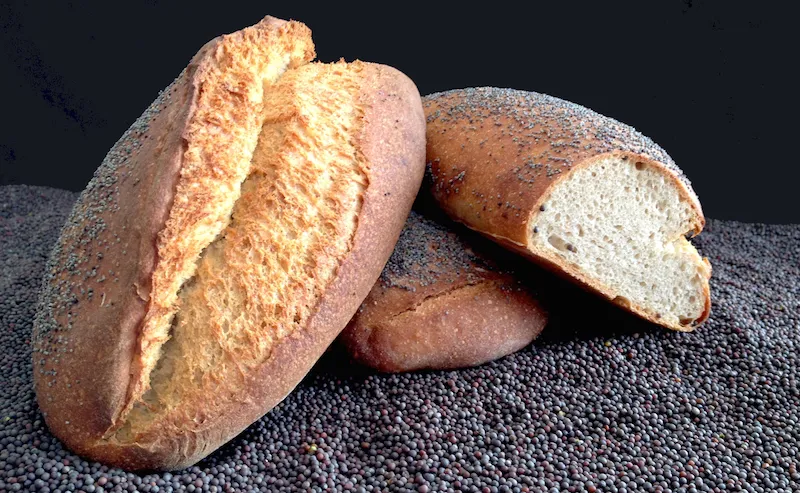
I cannot get the recipe template to work. Never mind, I'm posting it here instead.
Description
I love it when your own take on a bread is the latest addition to a chain that extends back into the mists of time. In this case, I was inspired by MC’s blog (http://www.farine-mc.com/2015/05/meet-baker-eric-marche.html) about Breton-based baker Éric Marché. In the blogpost she writes about how M.Marché roasts buckwheat flour for his menhir-shaped loaves. I’ve never been a huge fan of buckwheat bread, but this sounded worth a try. It was. It’s a great idea. Delicious.
This is my version of Éric Marché's loaf, using, as a template, Dan Leader’s Buckwheat Bâtard recipe which, apparently, he adapted, in turn, from an Éric Kayser recipe. Anyway, I hope I've done them justice.
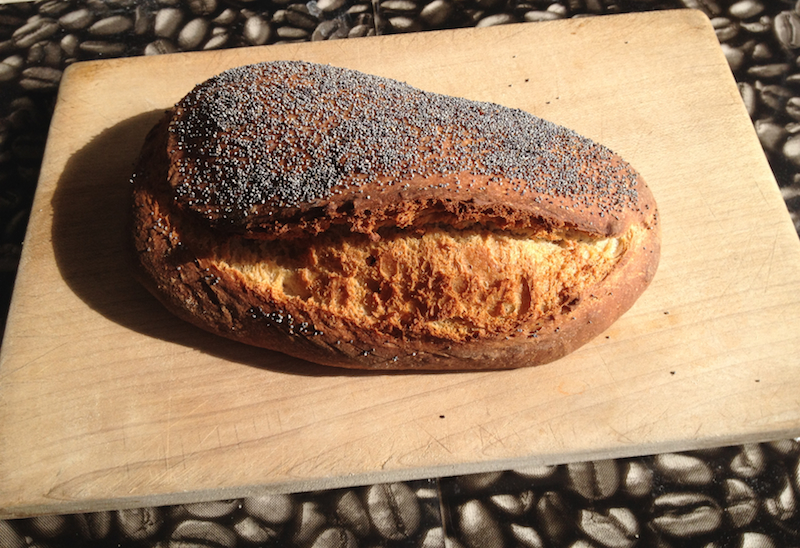
It makes a beautiful dough, easily handled and shaped. It’s ideal for long cold retardation (Éric Marché keeps his for up to two days). I sprinkled it with black poppy seeds because their flavour complements the buckwheat. I haven’t tweaked the colours at all. Buckwheat loaves really do bake to this rich russet golden colour.
I baked test batches with both white and wholemeal flours. They're equally good. The latter needs a much longer fermentation (double-hydration is also a good idea) and gives a more open crumb (see the photo on MC's blog).
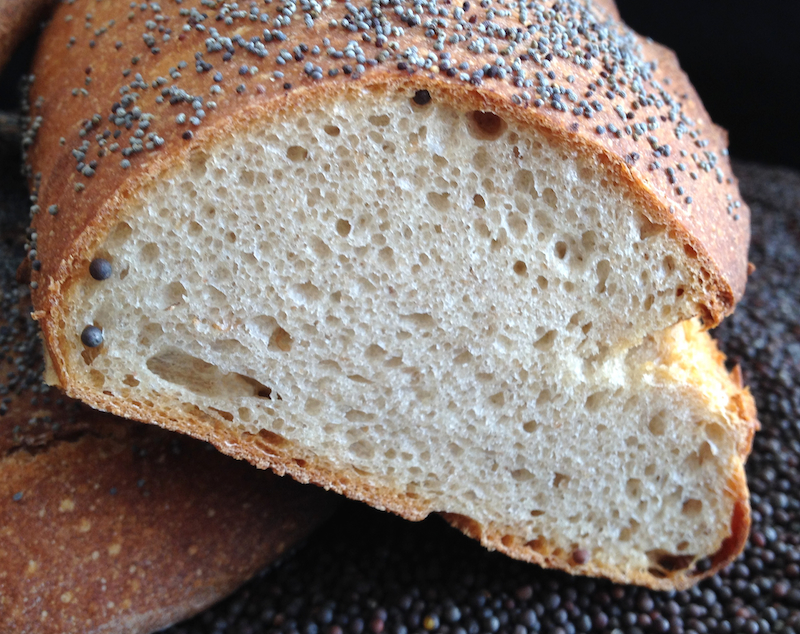
Makes 2 x 440g loaves (baked, approx).
INGREDIENTS
Levain:
- 40g liquid (100% hydration) sourdough starter
- 45g water
- 70g buckwheat flour
Dough:
- 130g buckwheat levain
- 300g water
- 450g unbleached bread flour, or wholemeal/wheatmeal
- 44g buckwheat flour
- 22g roast buckwheat flour
- 17g salt
- 1 tsp poppy seeds, optional
METHOD
Roast the buckwheat:
- Roast the buckwheat in a 160/140(fan)℃ (320/280F) oven for a total of 15 minutes (mixing it every 5 minutes to prevent it from burning.
To form the buckwheat levain:
- Mix the ingredients well, cover and let stand for 8-12 hours or overnight.
It makes a medium-stiff levain. Don't expect a huge amount of activity with buckwheat flour, but you should expect to see a moderate increase in volume.
Form the dough:
- Combine the buckwheat levain with the water. Break up the levain so it can be easily mixed with the rest of the ingredients.
- Add the bread/wholemeal flour, buckwheat, and roast buckwheat. Mix well.
- Autolyse for 30 minutes.
- Add the salt. and mix.
- Knead until the dough passes the windowpane test - about 5 minutes with a stand mixer (or 8-10 minutes by hand). You will have a smooth, creamy dough that still tears if you pull at it.
- Leave it in it's bowl, cover, then bulk ferment the dough for 1 hour.
- Stretch-and-fold in the bowl, rotating one quarter between folds for one complete turn of the bowl.
- Do the windowpane test. It you feel the gluten is still under-developed, do another stretch-and-fold.
- Cold retard for 6-10 hours (or overnight).
- Then gently de-gas, divide the dough, and pre-shape into boules or blunts. No need to be fancy: do it in four quick turns per boule - you don't want to rip the skin.
- Rest for 20 minutes.
- Shape into menhirs. To do this gently de-gas each boule/blunt again. Next flatten and stretch them into the form you'd use to shape a bâtard, but with one side being shorter than the other. Now stretch and fold under tension - again, just as you'd do with a bâtard - but don't seal the final fold with the heel of your hand, leave it as it is. You should now have two loaves, each in the shape of a blunt-nosed cone (see photo below).
- Set aside, make sure the seam is on the side of each loaf, cover, and prove for 1-2 hours.
- Preheat your oven to 230/210(fan)℃ (450/410F). Prepare your steam tray too.
- When the loaves are ready, spray their upper surfaces with water then sprinkle with seeds.
- Score to enhance the shape by running your lame along the seam on the side from tip to base.
- Steam the oven. I just pour water onto my steam tray which has been sitting in the oven for ten minutes. A few squirts of water onto your baking stone can also be a big help.
- Bake - immediately turning the heat down to 220/200(fan)℃ (430/400F) - for 25-30 minutes.
- Remove the steam tray after 15 minutes into the bake.
- Once the loaf turns a golden russet brown and the base is hollow to the tap, remove from the oven and set aside to cool.
Additional Notes: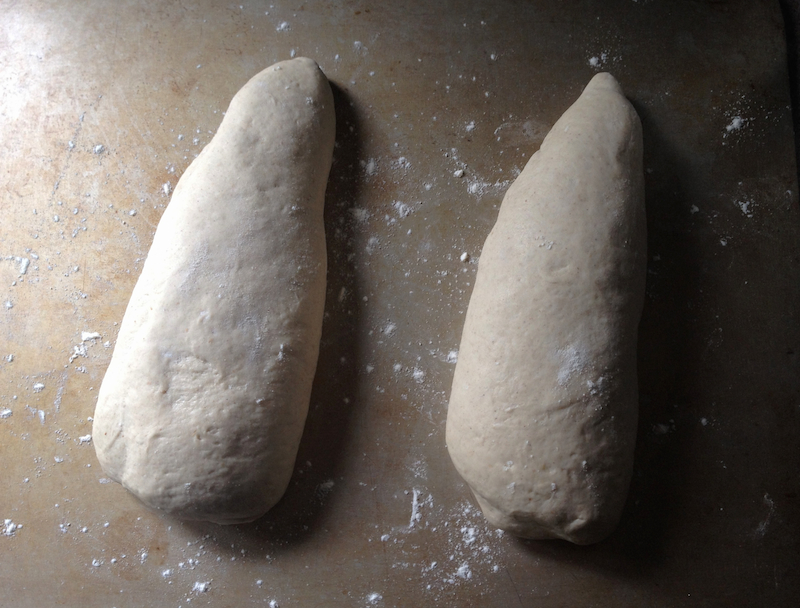
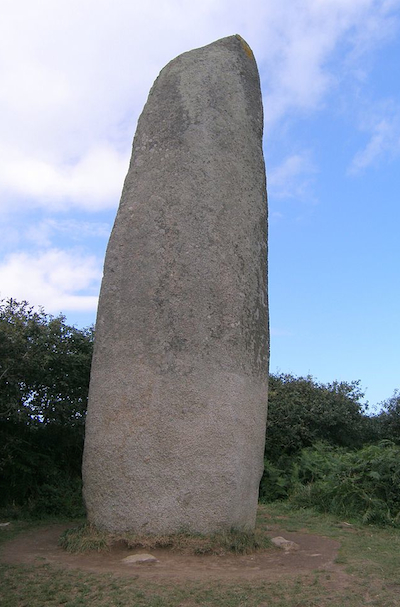
The Kerloas Menhir, Plouarzel, Brittany, France. (Creative Commons, China_Crisis)
Menhirs are ancient standing stones, sometimes six or seven thousand years old. Thousands of them are found in Britain (Stonehenge), Ireland, and northern France. In particular, they dot the landscape of Brittany (the forest of them at Carnac has to be seen to be believed), hence Éric’s inspiration.
And, as those of you who read Asterix and Obelix books as a kid will know, a menhir is also the giant rock Obelix uses habitually as a weapon to flatten Roman legionaries. I was a childhood fan (still am), so I just couldn’t resist.
Great with cheese or cured meats.
Wow, great post! Would you mind if I featured this on the homepage for a bit?
...Do you need a higher res image?
Nah, I think it looks fine as is.
Ils sont fou, ces boulangères! ;-)
Excellent information and bread. Really enjoyed this post - great pictures and the bread looks delicious. thank you
That's all I have to say about that.
Excellent instructions and I love the idea of replicating the ancient standing stones in bread.
Great looking bake and nice post!
What is the ingredient making the round dark spheres in the crumb? They look about 10 times larger than a poppy seed.
...I had a big bag at hand. It worked quite well as a sand-like replacement to spread on the tray and stop the vertical loaves in Breadhenge from falling over.
display touch under the loaves as well.
--- Do you get a extra burst of flavour when biting the bread?
This looks great. What temperatures do you use when not in the fridge? Just room temperature or... ?
... was 25℃ (77F), cold retard was at 5℃ (41F) - standard for most refrigerators - and they were proved at between 21-25℃ (70-75F) depending upon time of day and others dough cycles happening around each test batch I did.
The levain fermented happily at anything between 18-22℃ (64-71F) - ambient room temp.
All-in-all everything was pretty much at standard temps. Hope this helps.
stone monolith bread that isn't as hard as a rock and has a hunt of mustard taste:-) Well done and happy baking
Very nice loaf! Love the colors. I will have to try the addition of poppy seeds when I next use buckwheat in a loaf.
I was inspired by MC's blog too but I tweaked the formula a bit to include cinnamon, raisins and whole buckwheat tossed into the mix. Now I will have to try it un-tweaked.
Thanks for Sharing,
Janet
...of your loaf? Maybe post it here? It sounds great. Thank you - everyone - for the kind words.
...I've also posted a recipe that's my artisinal take on the famous carbonized loaf recovered from the ashes of Pompeii:
http://www.thefreshloaf.com/node/42934/artisan-pompeii-miche
Great delicious soft bread. My favorite so far. Instead of poppy i put sesame on top.